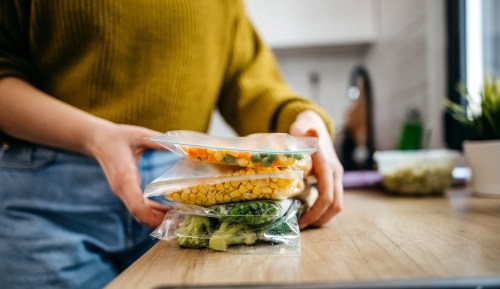Our editors independently select these products. Making a purchase through our links may earn Well+Good a commission
5 Tips for Freezing Leftovers Straight From a Meal Prep Expert
A meal prep expert gives tips on how to prevent freezer burn with five key tips for storing leftovers in the freezer.

Leftovers are glorious—and not just on the day after Thanksgiving. Having them tucked away in the fridge means you’ve got ready-to-eat meals that solely require a reheat right at your fingertips… what else can you ask for? There’s no checking your pantry to make sure you own all the ingredients. You don’t have to spend 20 minutes washing the dishes afterward. Just heat, eat, and relax. The one downfall to leftovers, however, is there are occasions in which you aren’t hankering for a dish you had for dinner less than 24 hours ago.
Experts in This Article
Leanne Miyasaki is a meal prep expert and the creator of the food blog Simple Healthy Dish.
This is exactly when freezing leftovers can come in handy. When stored correctly, food can last a long time in the freezer—almost indefinitely, in fact. That means you can save that Shepherd’s pie or enchilada casserole for weeks or months later, ready to pull out on nights when the “what’s for dinner” question is about to put you over the edge. The key, of course, is storing your leftovers properly. Otherwise, you’ll end up with unpleasant (or worse, inedible) freezer-burnt pasta bolognese, soup, or bean chili.
As a meal prepper and the creative force behind Simple Healthy Delish, Leanne Miyasaki has mastered the whole freezing leftovers thing. In her experience, she’s found that there are five key factors that matter. Here, she gives her insider tips on how to prevent freezer burn and store your leftovers properly.
Wondering how to prevent freezer burn? Put these 5 tips into practice when storing your leftovers:
1. Let your food cool before you store it.
Miyasaki says the number one mistake she sees people make when it comes to storing leftovers is putting the food into a container and stashing it away before it has the chance to fully cool. “If your leftovers are sealed and stored while they’re still warm, the steam will create moisture, causing the extra condensation to freeze. This can lead to the dreaded freezer burn,” she says. Because condensation causes freezer burn, anything you can do to eliminate moisture will help keep your leftovers tasting just-cooked once they’ve been reheated—especially letting your food cool before you freeze it.
2. Double-store your leftovers.
Your leftovers are already in a sealed container, but Miyasaki recommends storing the container in a resealable bag also to add another layer of protection. “Zessti ($22) makes a great reusable set of storage bags which are BPA-free and durable,” she says.
3. Store your leftovers in the center of the freezer.
It’s not just what your store your leftovers in that matters; Miyasaki says where you store them in the freezer does, too. ” Storing your meals towards the center of the freezer prevents the container from being too close to the coldest parts of the freezer, which is typically directly under the icebox,” she says. Miyasaki also recommends storing leftovers completely flat—not vertically or at a weird angle trying to cram it in there. “Flat storage allows for maximal storage space and a quicker thaw,” she explains.
4. Leftover produce can become ready-to-blend breakfasts.
When we hear the term ‘leftovers’ we tend to automatically conjure up images of containers filled with pasta or pad thai. All good, but don’t forget to freeze raw fruits and vegetables for future meals as well. Something Miyasaki says you’ll often find in her freezer are ready-to-blend smoothie packs. These, she says, come in handy on busy mornings. “Blended with some protein-packed Greek yogurt and a spoonful of nut butter becomes a quick and delicious meal, complete with all three macronutrients to get your day started. It’s also the best way to use fruit and greens before spoiling,” she says. BPA-free storage containers for this are easy to find on Amazon, like this set by Avant Grub Store for $13.
5. Use fresh ingredients to bring your leftovers back to life.
While this tip isn’t directly related to storage, it is key for making your leftovers not taste like, well, leftovers. “I always recommend adding fresh ingredients to the finished dish,” Miyasaki says. “Fresh herbs, citrus, diced onions, tomatoes, or avocado are the little touches that can make all the difference.” One simple fresh ingredient can completely transform your leftovers.
With these tips in mind, your leftovers will stay safe in the freezer until you’re ready for a repeat meal. The best part? No one will guess you cooked the meal ages ago.
Oh hi! You look like someone who loves free workouts, discounts for cutting-edge wellness brands, and exclusive Well+Good content. Sign up for Well+, our online community of wellness insiders, and unlock your rewards instantly.
Sign Up for Our Daily Newsletter
Get all the latest in wellness, trends, food, fitness, beauty, and more delivered right to your inbox.
Got it, you've been added to our email list.










